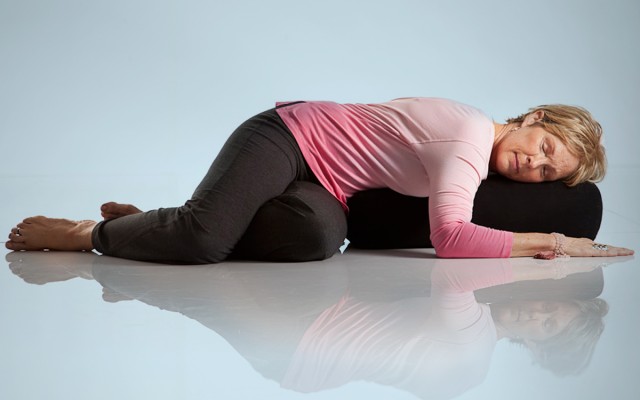The Benefits of Restorative Yoga: A Q&A with Sudha Carolyn Lundeen

Kripalu Schools faculty Sudha Carolyn Lundeen explains how restorative yoga impacts the nervous system, its applications in the healthcare field, and ways in which teachers can use this skill to enhance their yoga business.
How does training in restorative yoga benefit yoga teachers?
If you want to start broadening and diversifying the populations you work with and the venues you teach in, then further training is important. To offer yoga in a therapeutic way, it’s essential to have a full understanding of the clients’ needs in order to safely and skillfully guide them, whether you’re teaching all-levels or drop-in classes, or working with specific populations such as the elderly, those with limited mobility, pregnant women, or those recovering from injury or surgery. That’s why the Kripalu approach to restorative yoga, which emphasizes mindfulness, nonjudgment, and compassion, is so beautiful. It provides a foundation and principles that you can take into any situation and adjust accordingly.
I want to quickly point out the misconception that restorative yoga is just for the infirm, weak, or limited. Not true! It is wonderful, perhaps even more important, for the Type A, go-go-go, “more is better” orientations. Restorative yoga is the perfect antidote to the fast-paced, stress-inducing world we live in. Even adding one restorative pose at the end of a busy day, such as Legs Up the Wall, can reboot the nervous system.
How is restorative yoga helpful to yoga teachers who work in healthcare?
Any caregiver can benefit from knowing how to position a patient more comfortably, as well as working with the breath for stress management. Nurses can definitely take some of these tools into the medical arena. As an RN, I think back to my days working in rehab and the recovery room, and I wish I knew then what I know now about the benefits of breath, good alignment, and positioning using props, to help patients be more comfortable and, as a result, less anxious.
What are the physiological reactions that occur as a result of practicing restorative yoga?
The key here is support, via skillful placement of blankets, bolsters, cushions, straps, the wall, and even chairs, enabling the body to hold various yoga positions for longer times than we typically would hold active poses. For example, holding Balancing Half Moon pose for even five breaths without support can be challenging. But, practiced as a restorative pose, lying on your side with your ribs over a bolster, totally supported, you will be able to stay in the pose longer—which is what it takes to get to another level of relaxation, of quieting the body, mind, and breath. The parasympathetic nervous system is activated, cortisol decreases, insulin uptake changes, and there are positive effects on the immune system.
What are some of the areas in which teachers grow in a restorative yoga training?
Definitely in the areas of language, tone of voice, pacing, and, as we take it deeper, assisting and the ability to look at someone and get an energetic, intuitive understanding of what’s needed. Teachers increase their skills in customizing poses for students; making even tiny shifts in body alignment or the position of a prop can make a big difference in the student’s experience. It becomes an art, and that takes practice, coaching, and feedback, which you get in the training. You also learn how to be creative with the props you have. You won’t always have access to six blankets, bolsters, straps—but if you’ve got a wall and a sticky mat, maybe two, there are still many poses to offer. You can easily lead a 40-minute restorative class just using the wall.
What are some other ways to integrate restorative yoga into your teaching?
A lot of studios are finding that, when they schedule a Friday restorative class after work, people come in droves. It’s also great for private sessions—you can bring restorative poses into a session and teach students how to practice on their own, using particular postures to create balance or relieve stress. I notice that teachers are offering “restorative plus”—restorative plus Reiki, restorative plus healing touch, restorative plus gonging. It’s an amazing skill set to have in your toolbox.
Find out about upcoming programs and trainings with Sudha Carolyn Lundeen at Kripalu.
